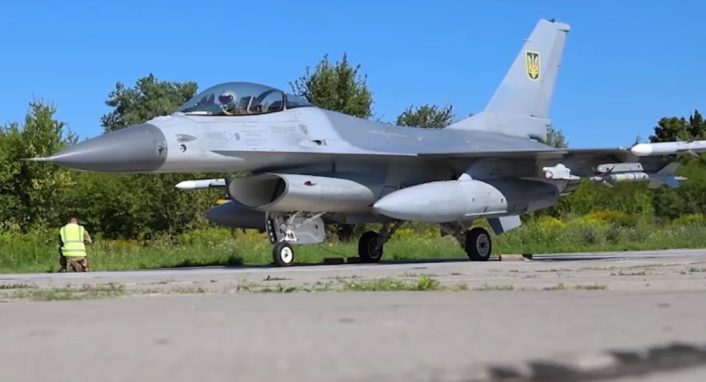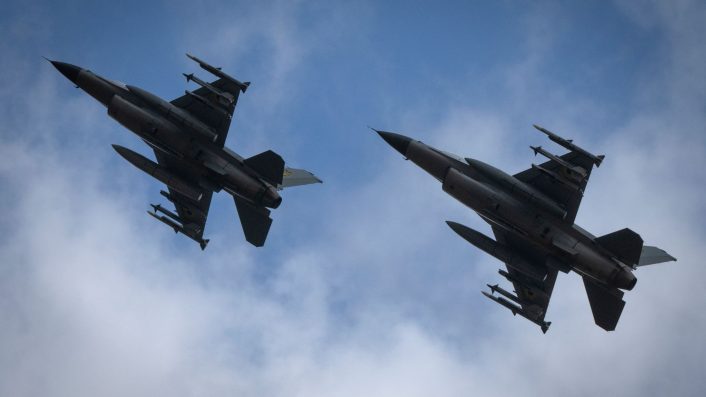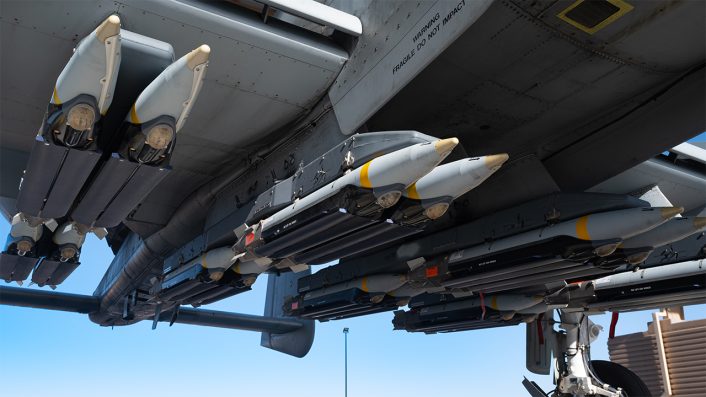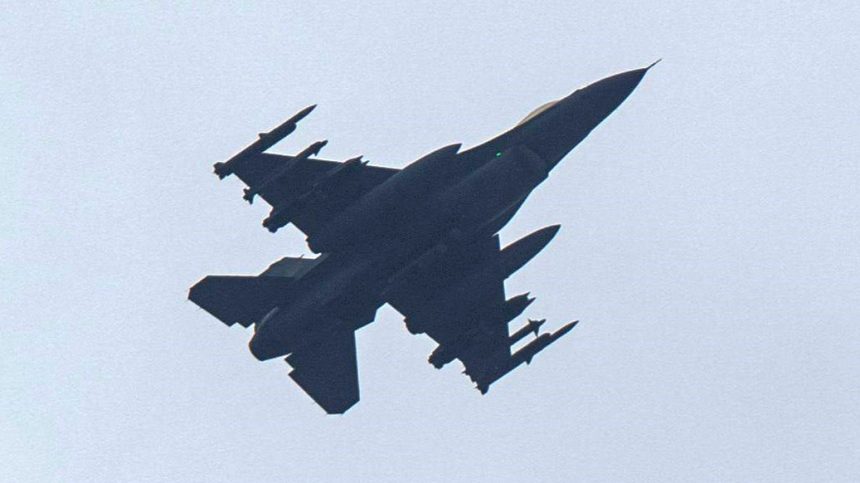After initially flying only air defense missions, a photo of a Ukrainian F-16 armed with eight GBU-39 SDBs confirms that the Vipers are also being employed in the air-to-ground role.
About six months after they were first delivered, the Ukrainian F-16s are now being employed for both air defense and air-to-ground attack missions. In fact, after a recent video appeared to show an F-16 armed with bombs during a low pass, the first photo of a Viper (as the F-16 is nicknamed by its crews) armed with GBU-39 Small Diameter Bombs (SDB) has now emerged online.
The F-16 in the photo is carrying a payload similar to what has already been seen on F-16s of other operators. Specifically, the aircraft is armed with a mix of AIM-120C AMRAAM, AIM-9L/M and AIM-9X Sidewinder air-to-air missiles and eight GBU-39 SDB glide bombs, as well as two 370 gallons external fuel tanks and an ALQ-131 Electronic Counter Measures pod.
Low pass by a Ukrainian Air Force F-16AM Fighting Falcon on a strike mission.
Armed with 8x GBU-39 SDB glide bombs, 1x AIM-9X Sidewinder, 1x AIM-9L Sidewinder, and 2x AIM-120C AMRAAMs. pic.twitter.com/0Hd45fzUIQ
— OSINTtechnical (@Osinttechnical) February 16, 2025
The loadout in the photo is definitely an improvement compared to the one seen in the official photos released upon delivery. In that occasion, the jet was armed only with the older AIM-120B and AIM-9L/M, although the newer AIM-120C and AIM-9X were already available to Ukraine and used by NASAMS air defense systems.
Earlier today, footage emerged of what is possibly the first sighting of a Ukrainian Air Force F-16AM Fighting Falcon on a strike mission, making a low-level pass.
These are the first images of a Ukrainian Falcon sporting a full loadout of US-supplied GBU-39 SDB glide bombs. pic.twitter.com/QTyoBffEJX
— OSINTtechnical (@Osinttechnical) February 10, 2025
The photo of the air-to-ground-configured F-16 follows the photo, emerged a week earlier, of a Viper returning from a daytime combat air patrol which showed it for the first time using the AIM-120C and AIM-9X.
Ukrainian Air Force F-16AM Fighting Falcon returning from a combat air patrol, having expended one of its AIM-120C-series AMRAAM missiles.
Appears to be the first confirmation that Ukrainian Falcons are sporting the more advanced and longer-ranged C-series AMRAAMS. pic.twitter.com/oK7TLUOCbW
— OSINTtechnical (@Osinttechnical) February 11, 2025
F-16 in Ukrainian Air Force service
After a prolonged wait, Ukraine finally received the initial delivery of F-16s from the international fighter jet coalition at the end of July. The news of the arrival of the jets in Ukraine was first reported by Bloomberg on July 31, 2024, and was later confirmed by a U.S. official to the Associated Press.
On Aug. 4, 2024, President Volodymyr Zelensky announced the arrival of Ukraine’s first batch of F-16 fighter jets. The delivery was celebrated with a private ceremony at an undisclosed location, where the aircraft were displayed alongside Zelensky and flew in formation overhead.
Around 85 F-16s (91 according to some reports) have been promised to Ukraine, of which 24 from the Netherlands, 19 from Denmark, 12 from Norway and 30 from Belgium. Ten more aircraft will be provided for spare parts by Norway.
The first F-16s transferred to Ukraine, reportedly a total of six aircraft, were from Denmark. A second batch was reportedly delivered in early December 2024, according to Ukrainian President Volodymyr Zelenskyi, with Defense Minister Rustem Umerov saying that Denmark has already handed over “most of the promised F-16s,” with the last batch to be delivered soon.
Early in February 2025, the Ukrainian government also acknowledged the delivery of a new batch of F-16s, this time from the Netherlands. It is unclear, however, how many have been delivered so far, as well as how many have been lost.

Photos released by the Ukrainian Air Force showed the jets equipped with Terma PIDS+ (Pylon Integrated Dispensing System) pylons, which also include UV Missile Warning Sensors. The pods in question have been fitted onto wing stations 3 and 7 and allow for increased chaff and flares capacity, as well as IR-guided missile’s approach warning.
In August 2024, shortly after the delivery, the U.S. Air Force disclosed its involvement in the upgrade of the electronic warfare (EW) suites of the Ukrainian F-16s. The service collaborated with Denmark and the Netherlands to develop, test and deliver full-spectrum Electromagnetic Warfare support.
To effectively integrate the F-16 into the Ukrainian Air Force, its EW subsystems required reprogramming to be effective against evolving Russian threats in the spectrum, said the press release. The service explicitly referred to a “reprogrammed pod,” possibly hinting at the ALQ-131 ECM pod seen in the photos.
The F-16s delivered to Ukraine are already compatible with many of the Western weapons that were integrated on the Ukrainian MiG-29s and Su-27 and will be able to employ these weapons more efficiently. Unconfirmed reports mention that Ukrainian F-16s might also get in future the possibility of employing the AGM-158 JASSM.
The versatile, multirole F-16 jets will augment and eventually replace Soviet-era fighters, which have been modified to use Western-donated weapons like the JDAM (Joint Direct Attack Munition), AGM-88 HARM (High-Speed Anti-Radiation Missile), ADM-160 MALD (Miniature Air-Launched Decoy), and the Storm Shadow/SCALP-EG ALCM (Air-Launched Cruise Missile), though these modifications have faced some difficulties.

The GBU-39 Small Diameter Bomb
As we already reported, the SDB is a small 250-lb multipurpose, insensitive, penetrating bomb with a blast-fragmentation warhead for stationary targets. It is equipped with deployable wings for extended standoff range that open upon release allowing the GPS-guided bomb to glide for several miles before hitting the target with accuracy: launched at high-speed from high altitude it can travel for as much as 50 miles, allowing the attack plane to remain outside the range of most SAM (Surface-to-Air Missile) batteries.
The GBU-39 first appeared in Ukraine in early 2024, with the Ukrainian military first announcing the use of the weapon in May. Before the F-16’s delivery, the weapon has been integrated on the MiG-29 Fulcrum and Su-27 Flanker, thanks to custom adapters under the jets’ original pylons which allow the use of the BRU-61 quadruple racks to install the SDBs.
The GBU-39 has been reported as largely resilient to the Russian electronic warfare systems, contrary to the ground launched variant GLSDSB whose effectiveness took a plunge due to jamming. Ukraine claims about 90% of the SDBs employed have struck their assigned targets.










